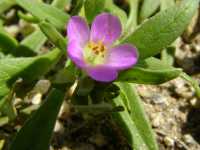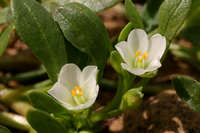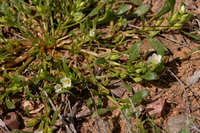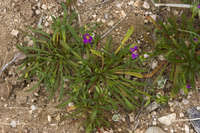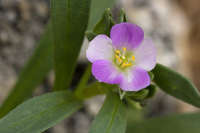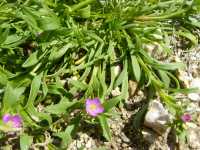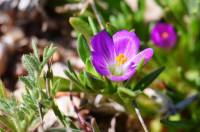Stems prostrate to ascending, spreading, 3-40 cm. Leaf blades linear to oblanceolate, 1-10 cm, glabrous or with elongate, 1-cellular hairs. Flowers: sepals 2.5-8 mm; petals 4-15 mm; stamens 3-15; pedicel ± straight in fruit, 0.4-2.5 cm. Capsules usually not exceeding calyx by 3+ mm. Seeds 10-20, 1-2.5 mm wide, finely reticulate at 30×. 2n = 24.
Flowering spring. Sandy to loamy soils, grassy areas, cultivated fields; 10-1900 m; B.C.; Ariz., Calif., N.Mex., Oreg., Wash.; w Mexico; Central America (Guatemala); nw South America.
Calandrina ciliata is highly variable vegetatively, especially in size, but is uniform in flower, fruit, and seed. It is very similar to C. breweri (see discussion above).
Herbs to 30 cm tall, from slender to thick taproot. STEMS spreading, prostrate to ascending.
LEAVES: linear to oblanceolate, to 10 cm long, glabrous or ciliate.
FLOWERS: 2-15; pedicels 4-13 mm long; sepals 2.5 - 8 mm long; petals 4-11 mm long, red to purple.
SEEDS: 5-20, elliptic, finely reticulate, 1-2.5 mm long. —Sandy to loamy soil, sand and gravel washes, rocky slopes.
Cochise, Gila, Graham, Maricopa, Mohave, Pima, Pinal, Santa Cruz, Yavapai cos.; 425-1550 m (1400 - 5100 ft); Feb-Jun; CA, OR, WA; w Mex., Guatemala, w S. Amer.
References: Allison Bair, Marissa Howe, Daniela Roth, Robin Taylor and Tina Ayers. 2006. Vascular Plants of Arizona: Portulacaceae. CANOTIA 2(1): 1-22.
Duration: Annual
Nativity: Native
Lifeform: Forb/Herb
General: Annual from slender to thick taproot, to 30 cm tall, spreading, prostrate to ascending.
Leaves: Alternate, linear to oblanceolate, to 10 cm long, glabrous or ciliate.
Flowers: Usually 2-15 on elongated raceme, leaf-like bracts, pedicels 4-13 mm long, sepals 2.5-8 mm long; petals 4-11 mm long, red to purple.
Fruits: Capsule with 3 valves, 5-20 seeds.
Ecology: Found on sandy to loamy soil, sand and gravel washes, rocky slopes from 1,500-5,000 ft (457-1524 m); flowers February-June.
Notes: There remains some uncertainty if this species is still in Portulacace or not. According to APG III this is the appropriate new family.
Ethnobotany: Seeds were eaten for food, as were the greens.
Etymology: Calandrinia is named for J.L. Calandrini (1703-1758) a Swiss botanist, while ciliata is the name given to describe slight fringing of petals like an eyelash.
Synonyms: Calandrinia ciliata var. menziesii
Editor: SBuckley, 2010




